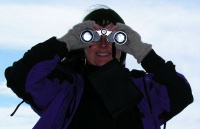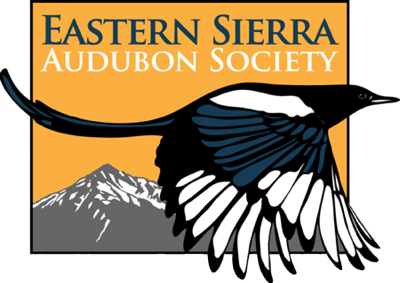
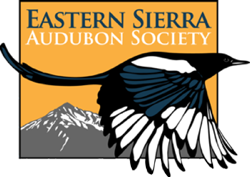
Sierra Wave
Newsletter
Volume 34, Number 2
November-December, 2015
Sierra Wave Newsletter
Volume 31, Number 4
March-April, 2013
Contents
- Events:
- Evening Program and Holiday Potluck, Wednesday, December 2
- Upcoming Field Trips and community events of interest:
- Features:
- Reports:
- Business
Events
Holiday Potluck Candlelight Dinner and Program, December 2nd, 6pm
The December 2nd meeting is also our annual Holiday potluck candlelight dinner, held at 6pm in the dining room of the White Mountain Research Center.
Do plan to attend as it is a fun event, and bring a friend or neighbor! Every participant should bring a dish (entrée, salad, or dessert to serve at least 6 people, and contribute either juice, soft drinks, wine or beer to the beverage table to share with all.) We often run out of food, so we would appreciate contributions of larger portions so there will be sufficient food for everyone. Please bring your own place setting. Audubon will provide coffee, tea, juice, and a touch of wine prior to the dinner. Also, we encourage you to focus on main dishes and salads rather than desserts, so we don't run out. Arrive by 6pm for our potluck dinner.
The dinner will be followed by a program at 7pm: Birds of the Amargosa
Join us at White Mountain Research Center, Owens Valley Station, on Wednesday December 2nd, 2015, for our annual holiday candlelight potluck dinner (6pm), followed by a special presentation by Len Warren, Birds of the Amargosa (7pm).

Female Phainopepla
Explore the Far East... of Inyo County, that is, with Len Warren of Shoshone in his program:
Birds of the Amargosa
Hi Eastern Sierra Audubon members. I'm Len Warren from Shoshone, California. I
have been studying the birds of the southern portion of the Amargosa
River since 2009. On December second I'd like to share with you some of my
photos, films, and experiences. My presentation, Birds of the Amargosa, will introduce the area and its birds. If you are
interested, my Blog site is birdman88-birdsofshoshonewetlands.blogspot.com or just google "Birds of Shoshone" and it should come right up. I'm looking
forward to seeing you.

Len Warren enjoying birdlife
Len Warren has been a nest searcher in Shoshone for Point Blue/PRBO's Amargosa Canyon Songbird Project for many seasons, and Staff Naturalist for Shoshone Village in the Fall/Winter seasons.
Shoshone-Tecopa is a California Important Bird Area (IBA), one of 6 IBAs in Inyo County.
Read more about this Important Bird Area here: http://esaudubon.org/birds/iba/shoshone-tecopa.php
Checklist of Birds of the Amargosa

Phainopepla Chicks
Back to Top
Upcoming ESAS Field Trips and Other Events
 Monthly Bishop Paiute Tribe COSA, Bird Walk and Census Dates:
Monthly Bishop Paiute Tribe COSA, Bird Walk and Census Dates:
- Saturday, November 14, 8:30am
- The December COSA Walk will coincide with the Christmas Bird Count on Saturday, December 19th! See more information below.
[Ed. Note: COSA walks are held on the second Saturday of every month, unless otherwise indicated]
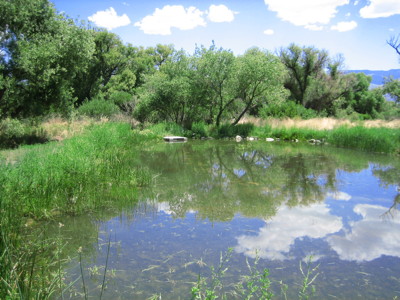
Spring has sprung in the COSA!
Unless otherwise indicated, our COSA bird walks will all be the second Saturday of the month, except (sometimes) for December, because we will have it coincide with the Christmas Bird Count. During June, July, August, and September they will start at 7:30 instead of 8:30. Watch the monthly email update, this field trips page, or local media for confirmation, updates on leader(s) and meeting time. Or, contact Hillary (below), or if you just show up at 8 or so, you'll probably find us!
The Conservation Open Space Area is being developed for wildlife and the community by the Bishop Paiute Tribe. We'll be keeping species lists and observing behavior as well as identifying birds, for the purpose of creating bird lists for the site. For more information, read this article on the COSA in the March-April 2013 Sierra Wave newsletter. There have been surprises every month so far - come find out what new birds we'll see next time - maybe you'll add toour bird list on e-Bird!
All are welcome - these walks are for birders of ALL LEVELS, beginners included! We will bring extra binoculars and field guides to share. If you'd like to print out a bird checklist, with blanks for adding your own discoveries, you can download that here: COSA Bird Checklist trifold (pdf)
Please meet at 7:30am in June-September, or 8:30am during October-May at the BLM/Forest Service Building on West Line Street in Bishop. Contact Hillary Behr for more information, or if you are interested in leading a future monthly walk: hillarybehr@yahoo.com.
Back to Top
STEPS FOR SNOW at Mono Lake: A Thanksgiving Promise to our Planet
Saturday, November 21 at 10am

Click image for flier
Walk a mile for Mono Lake, a future snowy Sierra and global climate progress at the Paris Climate Summit. Step up to support a renewable energy future and a commitment to care for our planet with personal action in solidarity with concerned citizens around the world.
Mono Lake has been a beacon of hope world-wide, a success story of balancing care for the environment with the needs of a thirsty population. But continuing drought, high temperatures and low snowfall are taking their toll, and Mono Lake is dropping despite the landmark decision to protect it in 1994.
Small actions from all of us add up to momentum and change in using and protecting our resources on Planet Earth. Shorter showers, removing lawns, installing solar, carpooling, walking and biking, turning off extra lights, lowering the thermostat a few degrees, recycling -- it takes all of our individual actions to make a difference. "Steps for Snow" ideas will be shared and taken home on special holiday ornaments made by local kids for participants.
Make a personal commitment to do what you can to reduce your carbon footprint, move towards a renewable energy future, stabilize Mono Lake and share in a moment of communal thanks for our beautiful Eastern Sierra.
Meet at the Mono Basin Scenic Area Visitor Center parking lot at 10am.
The walk to Mono Lake is mostly downhill. Shuttle available for return.
To skip the walk, join us at Old Marina, one mile north of Lee Vining, at 10:30am.
Dress warmly, bring water and snacks, and spend the day at Mono Lake!
Inclement weather or deep snow cancels. Call Janet for updates: 760-709-1162
Back to Top
Wild and Scenic Film Festival 2015 - A Wild Life
Join Friends of the Inyo in their 9th year of hosting the Wild and Scenic Film Festival!
- Thursday, December 3, Lone Pine, Museum of Western Film History, 6:15 pm
- Friday, December 4, Mammoth Lakes, Edison Theater, 6:15 pm
- Saturday, December 5, Bishop, Cerro Coso Community College, 6:15 pm
The Wild and Scenic Film Festival brings people and communities together through great films. The films focus on exploring the world with an emphasis on helping to take care of the environment.
Wild and Scenic Film Festival 2015 Information
Back to Top
 34th Annual Bishop Christmas Bird Count
34th Annual Bishop Christmas Bird Count
Eastern Sierra Audubon sponsors the Bishop Christmas Bird Count. The 34th annual Bishop Christmas Bird Count (CBC) is Saturday, December 19th, 2015. All skill levels are invited to participate. The CBC is an important citizen-science effort to census all birds in the Bishop area. Results show long term population trends and shifting demographics. Plus, it's a lot of fun!
Please RSVP as soon as possible to Chris Howard at chris93514@gmail.com, (760) 873-7422 (home), or (760) 920-2845 (cell), to join a team and let him know if you prefer a specific area or team-mate. He'd like to assign areas well in advance to give you a chance to scout. If you'd prefer to be a feeder-watcher, as opposed to covering an area, please let him know.
Here are a few of the exciting birds from 2014:
- Purple Finches - new to the Bishop count
- Yellow-bellied Sapsucker
- Pacific Wren
- Rough-legged Hawk
- Costa's and Anna's Hummingbirds
- Varied Thrush
- Common Yellowthroat
- Chipping Sparrow
- Lark Sparrows
- "Pink-sided" and "Gray-headed" Dark-eyed Juncos
- For more highlights and details, see the 2014 CBC summary here
Other Christmas Bird Counts in the region:
- Mono Basin CBC: Monday, December 14, 2015 - Contact Kristie Nelson, Phone:
760-709-1670
- Mammoth Lakes CBC: Sunday, December 20, 2015 - Contact: Bill Taylor, Phone: 760-709-6964
- Ash Meadows National Wildlife Refuge CBC, Nye County, NV & Inyo County, CA: Sunday, December 20, 2015 - Contact Annjanette Bagozzi
or Will Thomas, 775-372-5435
- Death Valley CBC: Saturday, January 2, 2016 - Contact Linda Manning, Phone: 760-786-3252.
See our CBC page for updates
Back to Top
Back to Top
Features
Birding Trip Documentation
The Art and Science of Field Notes
By Tom & Jo Heindel
Do you take notes regarding birding trips when you go into the field to bird? They are called field notes. What are field notes anyway and are they really necessary? Most good birders we know do take field notes and there must be a reason for that. There are different kinds of notes about bird trips. One kind is a small spiral bound notebook that usually fits into a shirt or jacket pocket in which we can jot down the date, time at our birding destinations, weather conditions, habitat visited, a list of birds with numbers, perhaps a description of a rare bird taken in the field at the time of the observation and anything else that you believe to be important. And today there are smart phones where you can enter birds as you see them, which certainly can make the numbers at the end of the day more accurate than waiting until dark before estimating how many of each of the species. There are times, unfortunately, when we do not know what is important. One early June in the 1960s, we were birding at the Patagonia Sanctuary in southeastern Arizona and noticed a Sulphur-bellied Flycatcher which we pointed out to the local expert. We were surprised when he got really excited; he had birded the area for many years and had never seen one there. We believed they would be regular because they breed in the nearby mountains. Had the local expert not been here to educate us, we would not have realized the significance of the sighting. We were not taking field notes in those days so we don't have the actual date or even the year of this memorable event.

There are other types of written documents that are kept by serious amateurs and professional ornithologists. One of the most important of these is the "journal." The journal is complete documentation of a birding trip. If done properly, it allows the author of the document or anyone else to read it at a later or much later date, a century perhaps, and have a clear picture of what happened that day. In our research on the birds of Inyo County, we have consulted the journals of early field workers that were here over a hundred years ago. They are on line and are extremely useful. We majored in Zoology at California State University, Long Beach in the 1960s and were first introduced to the "journal" every time we took a class that required field work, such as entomology, mammalogy, herpetology, ornithology etc. The system we used was called the Grinnell approach. Joseph Grinnell was the founder of the Museum of Vertebrate Zoology (MVZ) at Berkeley and is considered by many to be the dean of California ornithology. This system of field trip documentation was developed by Grinnell and his students and colleagues over the years and is still widely in use. Much time and effort was spent in laboriously preparing each page to receive the information to be added after a day in the field. Although this system began with pen and paper, it has been easily transferred into the electronic age. Today, with computers, the approach has been greatly simplified but the same information is still needed to paint a verbal picture that describes the important aspects of the day.
Each page has the author's name and date, including the year at the top left corner. Numbers are not used to indicate the month to avoid confusion such as 2-3-2015 can be interpreted as the third of February or the second of March. "2 MAR 2015" is the preferred format. The account begins with the route followed, the times and distances covered, as well as the names of all observers present. Weather is briefly covered including temperatures, wind direction, and cloud cover. Habitat should be described as well. Water level should be included, if appropriate, along with anything else the author feels might be relevant. "When in doubt, DON"T leave it out!" Then the bird species list follows with the numbers for each species and if they are estimates they should be indicated. Rare birds should be documented, including how similar species were eliminated (i.e., why was it a fall Bay-breasted Warbler and not the very similar Blackpoll or Pine Warbler). Articles have been written in journals on how to keep a personal journal (Remsen, J.V., Jr., American Birds 31(5): 946), in books (Zimmer, Kevin J., 2000), and entire books have been devoted to the topic (Herman, Steven J., 1986). This sounds like a lot of work, but if you decide to try it, the time spent learning how to do it well is worth it. You learn more about birds by writing about them. We didn't always think that way.

Grallaria erythrotis, Rufous-faced Antpitta
Joseph Smit, 1890
Catalogue of the birds in the British Museum. Volume 15
We have recently started our sixth decade of birding. We have had many experiences that we sure wish we had documented. In the early 1960s in the mountains of Ventura County, we had the good fortune to view 11 California Condors in flight at once, before any had been captured or tagged. We can't tell you the date, distance, how long they were under observation, how many were adults and immatures there were, etc. since we did not keep a journal. A couple years later on top of Mt. Pinos as we sat under a large shrub, a California Condor sailed by us at eye level 70ft away and looked at us. What a thrill! We can't tell you the date because our birding fun then didn't include writing anything down. But on 6 AUG 1979 in humid temperate forest habitat at 8400ft elevation on the east slope of the Andes Mountains of Bolivia, northeast of La Paz, on a clear day that would later turn cloudy and rain, Jo became the second living birder and Tom the third living birder to see a Rufous-faced Antpitta. Wow! What a rush!
We had been hearing this species call for a year and could not see it. Tom would imitate the call, the bird would come in closer and closer, calling back until it was able to see us though the dense vegetation. All we could see were the quivering of stems and leaves as it disappeared. We imitated the bird vocalization to visiting birders from Louisiana State University, Dr. J. V. Remsen and Ted Parker, and they agreed it was an antpitta but they could not be certain which one. On the day of our finally seeing the bird, we had just returned from a birding walk and Dr. Remsen had found the bird while we were gone and identified it. He told us that we were not going to see it by staying on the trail or what was left of an old overgrown road we often used. He said we would have to get down on the ground and crawl into the forest understory, find a place with a little visibility and sit, imitate the call, and hope for the best. We followed his directions and once seated Tom whistled. A bird immediately answered from afar and began his hunt for the intruder. Closer and closer the calls came. Jo spotted it first about three feet from her but Tom was blocked from seeing it. The bird immediately melted away. Our experience in the past was that once the bird saw us, it was gone. In an effort to save his marriage, Tom crawled back to the old road, ran about 50 feet up the hill, dove back into the understory, found a clear spot with a small rock on the other side, and whistled the call. Within seconds a Rufous-faced Antpitta jumped up on the small rock, threw its head back, gave the three note vocalization, and disappeared. We hoped to always remember most of the details of this event, but to write this story for the WAVE, we had to consult our journal for some of the details written 36 years ago. The time it took to write the story in our journal later that afternoon was miniscule to the joy of reliving, in detail, that amazing event these many decades later.
Two other types of documentation that advanced birders and field ornithologists keep are the Species Accounts and the Catalog. Species accounts are pages with the name of a species at the top of a page and the only thing entered on that page is about that species. Entries may just be that the species was encountered at a certain location on a certain day in a certain habitat, or that certain behavior was noted, or that a sex ratio was 1:1, or whatever else might be judged noteworthy. The third type of documentation is called the Catalog. This is a list of biological materials that are turned over to a museum or university and preserved for future study. Examples might be a dead bird, scat, plant material etc. Most birders do not maintain a Catalog or a Species Account, but most serious birders do keep a journal.
Some birders feel that keeping a list on eBird is all that is necessary. The list is a small but important part of a journal. eBird is a great way to keep a list, actually a database, but typically falls well short of painting an entire picture of what happened, including the details, in the field that day. The birds we observe on any given day are the result of weather conditions, wind patterns, the season, and many other aspects that the journal might explain. Herman (1986:200) states "NO JOURNAL THIS DAY, NO SLEEP THIS NIGHT" and his students amended it to "NO GRINNELL THIS NIGHT, NO GRANOLA TOMORROW."
We know this may sound like a major effort. It is not. It will become a habit, actually an addictive one, and we are thrilled that we crossed paths with those who were taught the value of and then the how-to maintain a journal and shared those lessons with us. So are the other birders who have done likewise. We can't tell you how often we consult the journals we have kept over the decades and how often they have helped us answer questions that we couldn't remember the answers to or confused the events, dates, locations, etc. If you live full lives and are lucky enough to live long enough…you will have filled up your personal RAM and your ancient OS won't be able to SORT as quickly or as accurately as it used to. But those journals, of the days when you wore a younger person's clothes, will fill all the gaps you so carefully tried to recreate. And then, if you are wise enough to insure they exist in perpetuity, you should consider housing your journals in a university, museum, library, etc. where they will be available to answer the questions of those who follow us…"What was it really like, waaaay back then?"
References
Herman, S. G. 1986. The Naturalist's Field Journal. Buteo Books. Vermillion, SD
Remsen, J. V. Jr. 1977. American Birds 31(5):946
Zimmer, K. J. 2000. Birding in the American West. Cornell Univ. Press. Ithaca, NY
Return to Top
Holiday Gift Ideas from ESAS
We know that this time of year can cause stress... what do you get those loved ones that have everything???

New baseball-style tee!
Might we suggest and ESAS T-shirt? We have lots of styles to choose from and all can be purchased at Spellbinder Books in Bishop. This year we have a few new styles, in addition to the variety of wonderful colors and short and long-sleeves. The new baseball-style is shown here, and we also have a relaxed "workout" long-sleeved shirt, and a women's V-neck style (in turquoise only). See our T-shirt page for more information.
But you say, you gave the family that gift last year!! Well have you ever considered a membership to the ESAS? It's a great gift and helps a local non-profit continue its work in providing birding programs and great field trips to the Eastern Sierra!! Click here for our online form!
Back to Top
Bird of the Month
Board Member Santiago Escruceria will be sharing a photo of a different bird each month - and all can be seen at the Bishop Paiute Tribe's COSA - join us there on the second Saturday of each month to see these birds and more! See upcoming field trips here.
Lesser Goldfinch
The Lesser Goldfinch is a small, short-tailed bird with a short, fat bill. The male’s underparts are plain yellow with a white patch at base of primaries, and a black cap with a dark back. The female has bright to dull yellow under parts and olive upper parts. Their song is a slower but continuous series of chips and whistles. Seen at COSA reserve, fairly common in the Eastern Sierra.

Lesser Goldfinch - photo by Santiago Escruceria
Sources:
- The Sibley Guide To Birds. Second Edition, 2014. Written and illustrated by David Allen Sibley.
- The Stokes Field Guide To The Birds Of North America. First Edition, 2010. Donald and Lillian Stokes.
- Birds Of The Sierra Nevada, Their Natural History, Status, And Distribution. 2013. Edward C. Beedy and Edward R. Pandolfino; Illustrated by Keith Hansen
Back to Top
Reports
Report: Owens Lake Conservation Update from Pete Pumphrey
The master Owens Lake Project California Environmental Quality Act (CEQA) preparation continues. The initial release is expected after the first of the year, most likely in February. The document will have input from Point Blue Science, a group doing the peer review on the Habitat Suitability Model for the CEQA, as well as modeling and analysis on the vegetation presence at the lake, information that will be used to develop resource protection criteria and be applied to any proposed groundwater pumping guidelines in the Master Plan. There is also language being developed to provide guidance to LADWP on how they notify the Habitat Work Group of any actions it plans to take or feels compelled to undertake on the lake bed. This final language will help to provide a long comment period to the greater community on actions taken regarding the lake.
Back to Top
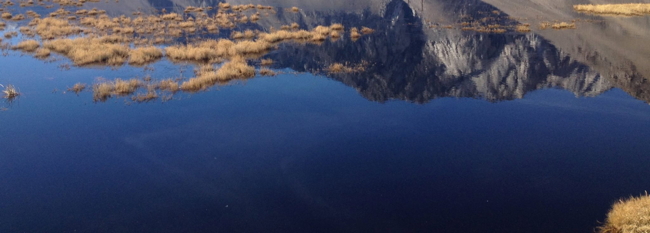
Cartago Springs Wildlife habitat at Owens Lake, Photo by Mike Prather
2016 Owens Lake Bird Festival - Save the Date! April 22-24, 2016
We are already at work preparing for next year's festival! There will be many new additions as well as making the event two days instead of one. Again there will be a Friday evening meet-and-greet reception at the Lone Pine Film History Museum followed by two days of field trips and more on Saturday and Sunday. We have added "crack of dawn" trips, trips away from the lake, talks on migration and shorebirds, history of Owens Lake, photography trips, geology and more! So everyone mark your calendars. See you there.
If you are interested in getting involved and helping make the 2016 Festival even better, read this letter for potential trip leaders or presenters (also gives a "sneak preview" of what is planned so far!)
See the Friends of the Inyo Owens Lake Bird Festival page for more information.
Michael Prather
Back to Top
Sierra To Sea Meadow Monitoring Project
A BIG thanks to everyone who helped out!
Results of the Sierra to Sea pilot program are in and great steps forward were made in gathering meadow data during the pilot program.
Earthwatch reports that 96 volunteers, ages 11 to 75 helped collect meadow data under the direction of 10 team leaders from 10 different partner organizations. All combined, 16 meadows were assessed and 457 species observations over 500 square miles were recorded!
A final data analysis is due out sometime at the first of the 2016 year and Earthwatch wants to extend a big thank you to everyone that contributed to this effort.
Back to Top
Taking Care of Business
Volunteer Service Announcement - we could really use your help
Please contact Ann Hoffmann at hoffmann@qnet.com or any ESAS board member for information about these opportunities to help,
January 12, 2016, 6 p.m., is our next scheduled Board Meeting.
Contact Ann Hoffmann for the location.
- Birds in the Classroom volunteers (Contact Hillary Behr)
- Board Member at Large
Constant Contact Email Coordinator (thank you, Katie!)- Field Trip Coordinator
- Field Trip LEADERS - if you have ideas for a field trip, let us know!
- Inyo/Mono County High School Scholarship Coordinator (Contact Roberta Lagomarsini)
- Newsletter Editor (Contact Maggie Riley or Katie Larsen)
- Webmaster (Contact Maggie Riley)
- Publicity Coordinator (Contact Jenny Richardson or Roberta Lagomarsini)
- T-Shirt Sales Coordinator (Contact Roberta Lagomarsini)
- Yard Sale Coordinator (Contact Roberta Lagomarsini)
- Volunteer Coordinator
- President... really we just need a person who is a good cat herder :)
Back to Top
Welcome New and Rejoining Members!
Thank you to the members who recently joined or renewed their membership!
We'd like to take a moment to promote Chapter Memberships: You may not be aware of this, but 100% of Chapter Membership dollars stays locally in the Eastern Sierra, supporting local education, youth, conservation, and programs. If you don't need Audubon Magazine, consider joining or renewing as a Chapter-only member, or better yet, as both Chapter and National! We do get support from National Audubon, as well, so any membership helps, and is money well-spent toward bird and wildlife conservation and education, and we thank you!
Your membership donations help keep this chapter alive. We get 8-10 renewing members a month, and from 3-5 new members. Your membership dues make it possible for us to offer and support great educational and recreational events throughout the eastern Sierra. Thank you!
If you would like to join and help support Eastern Sierra Audubon, there are two ways you can do it:
- Join as a National Audubon Society Member, designating ESAS as your chapter affiliation. Includes Audubon Magazine subscription. This is $20 a year.
- Join as an ESAS Chapter-only Member for $20 per year. 100% of your donation stays here in the Eastern Sierra this way. Your chapter membership is a way to give back, and show your appreciation for all that ESAS does, and to help support our mission locally. Your membership helps pay for scholarships, programs, special events, education programs, research, and more. THANK YOU for your support!
Click Here for a membership form to join or renew!
Join National Audubon - your zip code will associate you with the chapter nearest you.
Back to Top
Message from the Editor
Our next newsletter deadline will be December 15th for the
January-February issue, and of course you are always welcome to send submissions for future newsletters
and also the monthly email at any time.
We send out about one email each month to remind you of upcoming events - if you are not
on our email list, please
add yourself so you don’t miss anything!
If you send items to the newsletter
editor by the last week of any month, we’ll make sure they get included in
the next issue.
All of our content is supplied by our awesome members... if you have any ideas about articles you’d like to see, or better yet, if you have anything to share for newsletter publication, whether an article, a news item, update, correction, poem, essay, artwork, photo, field trip report, neat birding experience, letter, etc, please send it, along with any comments or suggestions, to the newsletter
editor. We’d love to hear from you!
You may send items for inclusion in the newsletter at any time, but please
send any timely items to arrive before the first of the month, so they can
be included in the monthly email update.
Thanks for reading, and happy birding!
Maggie Riley, Newsletter Editor
Back to Top
Calendar for November-December 2015
Back to Top
Final Shot

Groove-billed Ani, first spotted at Coso Junction by Steve Brad, joined soon by birders from near and far.
Photo by Bob Steele.
Back to Top
















